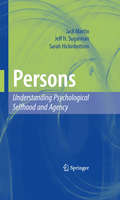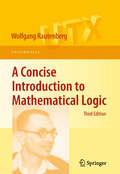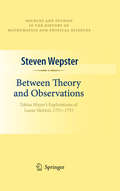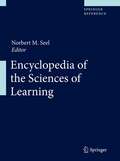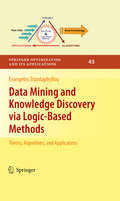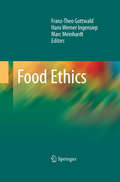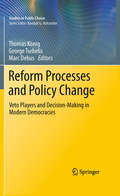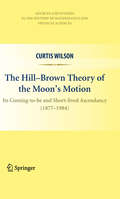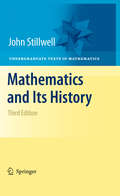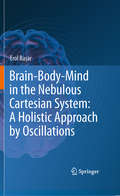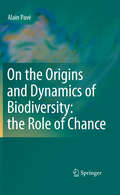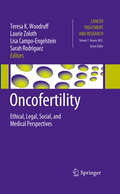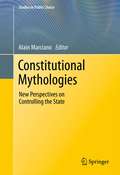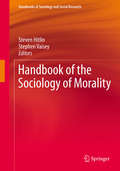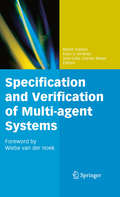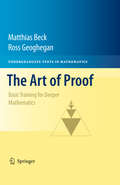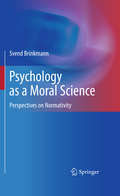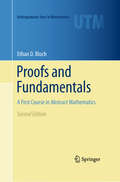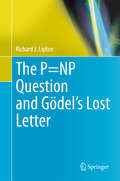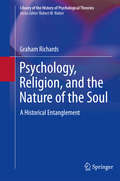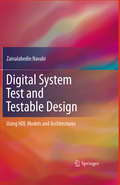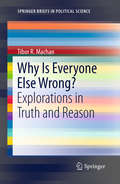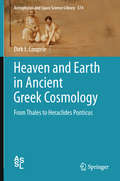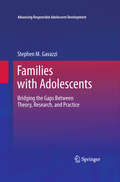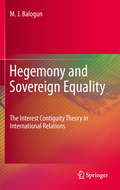- Table View
- List View
Persons: Understanding Psychological Selfhood And Agency
by Jack Martin Jeff H. Sugarman Sarah HickinbottomAt its core, psychology is about persons: their thinking, their problems, the improvement of their lives. The understanding of persons is crucial to the discipline. But according to this provocative new book, between current essentialist theories that rely on biological models, and constructionist approaches based on sociocultural experience, the concept of the person has all but vanished from psychology. Persons: Understanding Psychological Selfhood and Agency recasts theories of mind, behavior, and self, synthesizing a range of psychologists and philosophers to restore the centrality of personhood—especially the ability to make choices and decisions—to the discipline. The authors’ unique perspective de-emphasizes method and formula in favor of moral agency and life experience, reveals frequently overlooked contributions of psychology to the study of individuals and groups, and traces traditions of selfhood and personhood theory, including: The pre-psychological history of personhood, a developmental theory of situated, agentive personhood, the political disposition of self as a kind of understanding, Human agency as a condition of personhood, Emergentist theories in psychology, the development of the perspectival self. Persons represents an intriguing new path in the study of the human condition in our globalizing world. Researchers in developmental, social, and clinical psychology as well as social science philosophers will find in these pages profound implications not only for psychology but also for education, politics, and ethics.
A Concise Introduction to Mathematical Logic (Universitext)
by Wolfgang RautenbergMathematical logic developed into a broad discipline with many applications in mathematics, informatics, linguistics and philosophy. This text introduces the fundamentals of this field, and this new edition has been thoroughly expanded and revised.
Between Theory and Observations: Tobias Mayer's Explorations of Lunar Motion, 1751-1755 (Sources and Studies in the History of Mathematics and Physical Sciences)
by Steven WepsterIn the 18th century, purely scientific interests as well as the practical necessities of navigation motivated the development of new theories and techniques to accurately describe celestial and lunar motion. "Between Theory and Observations" presents a detailed and accurate account, not to be found elsewhere in the literature, of Tobias Mayer's important contributions to the study of lunar motion—including the creation of his famous set of lunar tables, which were the most accurate of their time.
Data Mining and Knowledge Discovery via Logic-Based Methods: Theory, Algorithms, and Applications (Springer Optimization and Its Applications #43)
by Evangelos TriantaphyllouThe importance of having ef cient and effective methods for data mining and kn- ledge discovery (DM&KD), to which the present book is devoted, grows every day and numerous such methods have been developed in recent decades. There exists a great variety of different settings for the main problem studied by data mining and knowledge discovery, and it seems that a very popular one is formulated in terms of binary attributes. In this setting, states of nature of the application area under consideration are described by Boolean vectors de ned on some attributes. That is, by data points de ned in the Boolean space of the attributes. It is postulated that there exists a partition of this space into two classes, which should be inferred as patterns on the attributes when only several data points are known, the so-called positive and negative training examples. The main problem in DM&KD is de ned as nding rules for recognizing (cl- sifying) new data points of unknown class, i. e. , deciding which of them are positive and which are negative. In other words, to infer the binary value of one more attribute, called the goal or class attribute. To solve this problem, some methods have been suggested which construct a Boolean function separating the two given sets of positive and negative training data points.
Food Ethics
by Franz-Theo Gottwald Hans Werner Ingensiep Marc MeinhardtIn this first decade of the 21st century, more than 854 million people in the world are starving, while industrial nations are debating about obesity, generating energy from food plants, and a myriad of other topics many African and south Asian nations could only fathom. In this great discord, there have arisen many interdisciplinary discussions about problems in the field of applied Ethics, with regards to food, that are crossing a considerably wide spectrum of disciplines, such as: obesity, traceability, agro-food biotechnology, dairy industry, transgenic plants, novel food, bio fuels, world-trade system, etc. This book presents international discussions and information concerning food ethics in its current state. It presents a variety of important aspects in the field of food ethics with respect to positions, instruments and applications of issues surrounding nutrition. A great deal of the book will concern itself with discussing different ethical positions and problems of current interests, as explained by experts of the "food-ethics-community". The articles will focus on the reality of global food problems through two main issues: current questions of nutrition in the specific contexts of field and experience, ethical tools, ideas and suggestions concerning long-term steps for solutions. The appendix presents a collection of current declarations and political statements – visions, proposals and goals in a worth living world in general and concerning specific problems - water, healthy food, the human right to food, sustainability and food sovereignty.
Reform Processes and Policy Change: Veto Players and Decision-Making in Modern Democracies (Studies in Public Choice #16)
by Thomas König, Marc Debus and George TsebelisGeorge Tsebelis’ veto players approach has become a prominent theory to analyze various research questions in political science. Studies that apply veto player theory deal with the impact of institutions and partisan preferences of legislative activity and policy outcomes. It is used to measure the degree of policy change and, thus, reform capacity in national and international political systems. This volume contains the analysis of leading scholars in the field on these topics and more recent developments regarding theoretical and empirical progress in the area of political reform-making. The contributions come from research areas of political science where veto player theory plays a significant role, including, positive political theory, legislative behavior and legislative decision-making in national and supra-national political systems, policy making and government formation. The contributors to this book add to the current scholarly and public debate on the role of veto players, making it of interest to scholars in political science and policy studies as well as policymakers worldwide.
The Hill-Brown Theory of the Moon’s Motion: Its Coming-to-be and Short-lived Ascendancy (1877-1984) (Sources and Studies in the History of Mathematics and Physical Sciences)
by Curtis WilsonThis book, in three parts, describes three phases in the development of the modern theory and calculation of the Moon's motion. Part I explains the crisis in lunar theory in the 1870s that led G.W. Hill to lay a new foundation for an analytic solution, a preliminary orbit he called the "variational curve." Part II is devoted to E.W. Brown's completion of the new theory as a series of successive perturbations of Hill's variational curve. Part III describes the revolutionary developments in time-measurement and the determination of Earth-Moon and Earth-planet distances that led to the replacement of the Hill–Brown theory in 1984.
Mathematics and Its History (Undergraduate Texts in Mathematics)
by John StillwellFrom a review of the second edition:"This book covers many interesting topics not usually covered in a present day undergraduate course, as well as certain basic topics such as the development of the calculus and the solution of polynomial equations. The fact that the topics are introduced in their historical contexts will enable students to better appreciate and understand the mathematical ideas involved...If one constructs a list of topics central to a history course, then they would closely resemble those chosen here."(David Parrott, Australian Mathematical Society)This book offers a collection of historical essays detailing a large variety of mathematical disciplines and issues; it’s accessible to a broad audience. This third edition includes new chapters on simple groups and new sections on alternating groups and the Poincare conjecture. Many more exercises have been added as well as commentary that helps place the exercises in context.
Brain-Body-Mind in the Nebulous Cartesian System: A Holistic Approach by Oscillations
by Erol BaşarBrain-Body-Mind in the Nebulous Cartesian System: A Holistic Approach by Oscillations is a research monograph, with didactical features, on the mechanisms of the mind, encompassing a wide spectrum of results and analyses. The book should appeal to scientists and graduate students in the fields of neuroscience, neurology, psychiatry, physiology, psychology, physics and philosophy. Its goals are the development of an empirical-analytical construct, denoted as “Reasonings to Approach the Mind”, and the comprehension of 20 principles for understanding the mind. This book amalgamates results from work on the brain, vegetative system, brains in the evolution of species, the maturing brain, dynamic memory, emotional processes, and cognitive impairment in neuro-psychiatric disorders (Alzheimer, Schizophrenia, Bipolar disorders). The findings are comparatively evaluated within the framework of brain oscillations and neurotransmitters. Further, a holistic approach links the brain to the cardiovascular system and overall myogenic coordination of the vegetative system. The results emphasize that EEG oscillations, ultraslow oscillations, and neurotransmitters are quasi-invariant building blocks in brain-body-mind function and also during the evolution of species: The temporal domain is where the importance of research on neural oscillators is indispensable. The core, holistic concept that emerges is that the brain, spinal cord, overall myogenic system, brain-body-oscillations, and neurotransmitters form a functional syncytium. Accordingly, the concept of “Syncytium Brain-Body-Mind” replaces the concept of “Mind”. P>
On the Origins and Dynamics of Biodiversity: The Role Of Chance
by Alain PavéChance is necessary for living systems – from the cell to organisms, populations, communities and ecosystems. It is at the heart of their evolution and diversity. Long considered contingent on other factors, chance both produces random events in the environment, and is the product of endogenous mechanisms - molecular as well as cellular, demographic and ecological. This is how living things have been able to diversify themselves and survive on the planet. Chance is not something to which Life has been subjected; it is quite simply necessary for Life. The endogenous mechanisms that bring it about are at once the products and the engines of evolution, and they also produce biodiversity. These internal mechanisms – veritable “biological roulettes” - are analogous to the mechanical devices that bring about “physical chance”. They can be modeled by analogous mathematical equations. This open the way of a global modeling of biodiversity dynamics, but we need also to gather quantitative data in both the laboratory setting as well as in the field. By examining biodiversity at all scales and all levels, this book seeks to evaluate the breadth of our knowledge on this topical subject, to propose an integrated look at living things, to assess the role of chance in its dynamics, in the evolutionary processes and also to imagine practical consequences on the management of living systems.
Oncofertility: Ethical, Legal, Social, and Medical Perspectives (Cancer Treatment and Research #156)
by Teresa K. Woodruff Laurie Zoloth Lisa Campo-Engelstein Sarah RodriguezOncofertility has emerged as a way to address potential lost or impaired fertility in cancer patients and survivors, with active biomedical research that is developing new ways to help these individuals preserve their ability to have biological children. In order to move beyond oncofertility as a science and medical technology and begin to address the ethical, legal, and social ramifications of this emerging field, we must give voice to scholars from the humanities and social sciences to engage in a multidisciplinary discussion. This book brings together a pool of experts from a variety of fields, including communication, economics, ethics, history, law, religion, and sociology, to examine the complex issues raised by recent developments in oncofertility and to offer advice from national and international perspectives as we create new technology. Given the inherent interdisciplinary nature of oncofertility, this book is not only valuable, but also necessary to cultivate a deep understanding of new issues with the eventual aim of offering proposals for addressing them. Indeed, this book will be useful for people not only within the humanities and social sciences disciplines but also for those who are confronted with cancer and the possibility of impaired fertility and the medical practitioners within oncology and reproductive medicine who are at the front lines of this emerging field.
Constitutional Mythologies: New Perspectives on Controlling the State (Studies in Public Choice #23)
by Alain MarcianoOur societies obviously rest on common beliefs. These "myths" are tools that help us to develop and build common identities; they form the structure around which societies function. This does not imply that these beliefs are “true,” in the sense that they would be supported by empirical facts. In social matters, myths have undoubtedly important functions to play even if no empirical facts support them. On the other hand, and precisely because they are not discussed, myths may be problematic: they may create illusions, conserve structures that are inefficient and unable to improve the situation of citizens. This is particularly true with constitutions. Constitutions are very important for societies: a constitution is a document — even in societies based on “unwritten” constitutions — which binds citizens together, creating unity among them, and which forms the framework within which our activities take place. As Nobel Prize laureate James Buchanan used to say: constitutions contain the rules of the social game we play in our everyday life. However, constitutions are not frequently debated by citizens. This is why we end up with common beliefs about these constitutions: they are above our heads, around us. We take them, their role, function, and nature as given. The purpose of this volume to investigate and challenge common constitutional myths. Featuring contributions from prominent economists, political scientists, and legal scholars, the chapters in this volume address such myths as “constitutions are binding social contracts,” “constitutions are economic documents” and “constitutions are legal documents.” Illustrating their analyses with historical and contemporary examples from the United States, Canada, and Europe, the authors build a multi-layered approach to understanding constitutions and their implications for social and political influence.
Handbook of the Sociology of Morality (Handbooks of Sociology and Social Research)
by Steven Hitlin Stephen VaiseyHuman beings necessarily understand their social worlds in moral terms, orienting their lives, relationships, and activities around socially-produced notions of right and wrong. Morality is sociologically understood as more than simply helping or harming others; it encompasses any way that individuals form understandings of what behaviors are better than others, what goals are most laudable, and what "proper" people believe, feel, and do. Morality involves the explicit and implicit sets of rules and shared understandings that keep human social groups intact. Morality includes both the "shoulds" and "should nots" of human activity, its proactive and inhibitive elements. At one time, sociologists were centrally concerned with morality, issues like social cohesion, values, the goals and norms that structure society, and the ways individuals get socialized to reproduce those concerns. In the last half-century, however, explicit interest in these topics has waned, and modern sociology has become uninterested in these matters and morality has become marginalized within the discipline. But a resurgence in the topic is happening in related disciplines – psychology, neurology, philosophy, and anthropology - and in the wider national discourse. Sociology has much to offer, but is not fully engaged in this conversation. Many scholars work on areas that would fall under the umbrella of a sociology of morality but do not self-identify in such a manner, nor orient their efforts toward conceptualizing what we know, and should know, along these dimensions. The Handbook of the Sociology of Morality fills a niche within sociology making explicit the shared concerns of scholars across the disciplines as they relate to an often-overlooked dimension of human social life. It is unique in social science as it would be the first systematic compilation of the wider social structural, cultural, cross-national, organizational, and interactional dimension of human moral (understood broadly) thought, feeling, and behavior.
Specification and Verification of Multi-agent Systems
by Mehdi Dastani Koen V. Hindriks John-Jules MeyerSpecification and Verification of Multi-agent Systems presents a coherent treatment of the area of formal specification and verification of agent-based systems with a special focus on verification of multi-agent programs. This edited volume includes contributions from international leading researchers in the area, addressing logical formalisms and techniques, such as model checking, theorem proving, and axiomatisations for (semi) automatic verification of agent-based systems. Chapters include: • Using Theorem Proving to Verify Properties of Agent Programs • The Refinement of Multi-Agent Systems • Model Checking Agent Communication • Directions for Agent Model Checking • Model Checking Logics of Strategic Ability: Complexity • Correctness of Mult-Agent Programs: A Hybrid Approach • The Norm Implementation Problem in Normative Multi-Agent Systems • A Verification Logic for GOAL Agents • Using the Maude Term Rewriting Language for Agent Development with Formal Foundations • The Cognitive Agents Specification Language and Verification Environment • A Temporal Trace Language for Formal Modelling and Analysis of Agent Systemns • Assurance of Agent Systems: What Role Should Formal Verification Play? Specification and Verification of Multi-agent Systems is a comprehensive guide that makes a useful tool for researchers, practitioners and students, and serves as a reference work summarizing the state of the art in an accessible manner.
The Art of Proof: Basic Training for Deeper Mathematics (Undergraduate Texts in Mathematics)
by Matthias Beck Ross GeogheganThe Art of Proof is designed for a one-semester or two-quarter course. A typical student will have studied calculus (perhaps also linear algebra) with reasonable success. With an artful mixture of chatty style and interesting examples, the student's previous intuitive knowledge is placed on solid intellectual ground. The topics covered include: integers, induction, algorithms, real numbers, rational numbers, modular arithmetic, limits, and uncountable sets. Methods, such as axiom, theorem and proof, are taught while discussing the mathematics rather than in abstract isolation. The book ends with short essays on further topics suitable for seminar-style presentation by small teams of students, either in class or in a mathematics club setting. These include: continuity, cryptography, groups, complex numbers, ordinal number, and generating functions.
Psychology as a Moral Science: Perspectives on Normativity
by Svend BrinkmannWhat does morality have to do with psychology in a value-neutral, postmodern world? According to a provocative new book, everything. Taking exception with current ideas in the mainstream (including cultural, evolutionary, and neuropsychology) as straying from the discipline’s ethical foundations, Psychology as a Moral Science argues that psychological phenomena are inherently moral, and that psychology, as prescriptive and interventive practice, reflects specific moral principles. The book cites normative moral standards, as far back as Aristotle, that give human thoughts, feelings, and actions meaning, and posits psychology as one of the critical methods of organizing normative values in society; at the same time it carefully notes the discipline’s history of being sidetracked by overemphasis on theoretical constructs and physical causes—what the author terms “the psychologizing of morality.” This synthesis of ideas brings an essential unity to what can sometimes appear as a fragmented area of inquiry at odds with itself. The book’s “interpretive-pragmatic approach”: • Revisits core psychological concepts as supporting normative value systems. • Traces how psychology has shaped society’s view of morality. • Confronts the “naturalistic fallacy” in contemporary psychology. • Explains why moral science need not be separated from social science. • Addresses challenges and critiques to the author’s work from both formalist and relativist theories of morality. With its bold call to reason, Psychology as a Moral Science contains enough controversial ideas to spark great interest among researchers and scholars in psychology and the philosophy of science.
Proofs and Fundamentals: A First Course in Abstract Mathematics (Undergraduate Texts in Mathematics)
by Ethan D. Bloch“Proofs and Fundamentals: A First Course in Abstract Mathematics” 2nd edition is designed as a "transition" course to introduce undergraduates to the writing of rigorous mathematical proofs, and to such fundamental mathematical ideas as sets, functions, relations, and cardinality. The text serves as a bridge between computational courses such as calculus, and more theoretical, proofs-oriented courses such as linear algebra, abstract algebra and real analysis. This 3-part work carefully balances Proofs, Fundamentals, and Extras. Part 1 presents logic and basic proof techniques; Part 2 thoroughly covers fundamental material such as sets, functions and relations; and Part 3 introduces a variety of extra topics such as groups, combinatorics and sequences. A gentle, friendly style is used, in which motivation and informal discussion play a key role, and yet high standards in rigor and in writing are never compromised. New to the second edition: 1) A new section about the foundations of set theory has been added at the end of the chapter about sets. This section includes a very informal discussion of the Zermelo– Fraenkel Axioms for set theory. We do not make use of these axioms subsequently in the text, but it is valuable for any mathematician to be aware that an axiomatic basis for set theory exists. Also included in this new section is a slightly expanded discussion of the Axiom of Choice, and new discussion of Zorn's Lemma, which is used later in the text. 2) The chapter about the cardinality of sets has been rearranged and expanded. There is a new section at the start of the chapter that summarizes various properties of the set of natural numbers; these properties play important roles subsequently in the chapter. The sections on induction and recursion have been slightly expanded, and have been relocated to an earlier place in the chapter (following the new section), both because they are more concrete than the material found in the other sections of the chapter, and because ideas from the sections on induction and recursion are used in the other sections. Next comes the section on the cardinality of sets (which was originally the first section of the chapter); this section gained proofs of the Schroeder–Bernstein theorem and the Trichotomy Law for Sets, and lost most of the material about finite and countable sets, which has now been moved to a new section devoted to those two types of sets. The chapter concludes with the section on the cardinality of the number systems. 3) The chapter on the construction of the natural numbers, integers and rational numbers from the Peano Postulates was removed entirely. That material was originally included to provide the needed background about the number systems, particularly for the discussion of the cardinality of sets, but it was always somewhat out of place given the level and scope of this text. The background material about the natural numbers needed for the cardinality of sets has now been summarized in a new section at the start of that chapter, making the chapter both self-contained and more accessible than it previously was. 4) The section on families of sets has been thoroughly revised, with the focus being on families of sets in general, not necessarily thought of as indexed. 5) A new section about the convergence of sequences has been added to the chapter on selected topics. This new section, which treats a topic from real analysis, adds some diversity to the chapter, which had hitherto contained selected topics of only an algebraic or combinatorial nature. 6) A new section called ``You Are the Professor'' has been added to the end of the last chapter. This new section, which includes a number of attempted proofs taken from actual homework exercises submitted by students, offers the reader the opportunity to solidify her facility for writing proofs by critiquing these submissions as if she were the instructor for the course. 7) All known errors have been corrected. 8) Many minor adjustments of wording have been made throughout the text, with the hope of i
The P=NP Question and Gödel’s Lost Letter
by Richard J. Lipton? DoesP=NP. In just ?ve symbols Dick Karp –in 1972–captured one of the deepest and most important questions of all time. When he ?rst wrote his famous paper, I think it’s fair to say he did not know the depth and importance of his question. Now over three decades later, we know P=NP is central to our understanding of compu- tion, it is a very hard problem, and its resolution will have potentially tremendous consequences. This book is a collection of some of the most popular posts from my blog— Godel ¨ Lost Letter andP=NP—which I started in early 2009. The main thrust of the blog, especially when I started, was to explore various aspects of computational complexity around the famousP=NP question. As I published posts I branched out and covered additional material, sometimes a timely event, sometimes a fun idea, sometimes a new result, and sometimes an old result. I have always tried to make the posts readable by a wide audience, and I believe I have succeeded in doing this.
Psychology, Religion, and the Nature of the Soul: A Historical Entanglement (Library of the History of Psychological Theories)
by Graham RichardsNeither a book about the psychology of spirituality nor America’s ongoing turf wars between religion and science, Psychology, Religion, and the Nature of the Soul takes to task many of the presumed relationships between the two—from sharing common concerns to diametrically hostile opposites—to analyze the myriad functions religion and psychology play in our understanding of the human life and mind.Graham Richards takes the historical and philosophical long view in these rigorous and readable essays, which trace three long-running and potentially outmoded threads: that psychology and religion are irrelevant to each other, that they are complementary and should collaborate, and that one will eventually replace the other. He references a stunning variety of texts (from Freud and Allport to Karen Armstrong and Paul Tillich) reflecting the evolution of these ideas over the decades, to emphasize both the complexity of the issues and the enduring lack of easy answers. The eloquence of the writing and passionate objectivity of the argument will interest readers on all sides of the debate as the author examines: the religious origins of psychology, the original dichotomy: mythos versus logos, the authenticity of religious experience, Religion and personality, the problematic role of prayer and Religion in the history of psychotherapy.For those making a serious study of the history of psychology, Psychology, Religion, and the Nature of the Soul will inspire a fresh wave of critical discussion and inquiry.
Digital System Test and Testable Design: Using HDL Models and Architectures
by Zainalabedin NavabiThis book is about digital system testing and testable design. The concepts of testing and testability are treated together with digital design practices and methodologies. The book uses Verilog models and testbenches for implementing and explaining fault simulation and test generation algorithms. Extensive use of Verilog and Verilog PLI for test applications is what distinguishes this book from other test and testability books. Verilog eliminates ambiguities in test algorithms and BIST and DFT hardware architectures, and it clearly describes the architecture of the testability hardware and its test sessions. Describing many of the on-chip decompression algorithms in Verilog helps to evaluate these algorithms in terms of hardware overhead and timing, and thus feasibility of using them for System-on-Chip designs. Extensive use of testbenches and testbench development techniques is another unique feature of this book. Using PLI in developing testbenches and virtual testers provides a powerful programming tool, interfaced with hardware described in Verilog. This mixed hardware/software environment facilitates description of complex test programs and test strategies.
Why Is Everyone Else Wrong?: Explorations in Truth and Reason (SpringerBriefs in Political Science)
by Tibor R. MachanEspecially when there is a lot of political rhetoric in the air, those of us with strong political convictions are inclined to reflect on just why we hold certain views even as others who are basically like us hold very different ones. Social scientists and other thinkers struggle to explain it, but the puzzle remains—in part because they, too, disagree so much with one another. Whether the arena is politics, religion, business, scientific research, or education, individuals who operate in the same environment and experience the same conditions may have radically different interpretations of the facts and diametrically opposed convictions about how to react to them. When faced with a fundamental disagreement, we ask ourselves: Why are these folks so wrong? And how can they be so convinced that we are wrong? In this provocative monograph, Tibor Machan explores the principles of truth, reason, and ideology, with particular respect to the profound political, economic, and social crises gripping the world today. In so doing, he not only sheds light on the nature of “truth” but also suggests a framework for embracing differences to come up with creative solutions.
Heaven and Earth in Ancient Greek Cosmology: From Thales to Heraclides Ponticus (Astrophysics and Space Science Library #374)
by Dirk L. CouprieIn Miletus, about 550 B.C., together with our world-picture cosmology was born. This book tells the story. In Part One the reader is introduced in the archaic world-picture of a flat earth with the cupola of the celestial vault onto which the celestial bodies are attached. One of the subjects treated in that context is the riddle of the tilted celestial axis. This part also contains an extensive chapter on archaic astronomical instruments. Part Two shows how Anaximander (610-547 B.C.) blew up this archaic world-picture and replaced it by a new one that is essentially still ours. He taught that the celestial bodies orbit at different distances and that the earth floats unsupported in space. This makes him the founding father of cosmology. Part Three discusses topics that completed the new picture described by Anaximander. Special attention is paid to the confrontation between Anaxagoras and Aristotle on the question whether the earth is flat or spherical, and on the battle between Aristotle and Heraclides Ponticus on the question whether the universe is finite or infinite.
Families with Adolescents: Bridging the Gaps Between Theory, Research, and Practice (Advancing Responsible Adolescent Development)
by Stephen GavazziDespite their flocking to social networking sites in unprecedented numbers, research confirms that adolescents continue to be influenced primarily by their families rather than their peers and other social contexts. Consequently, the family unit remains a vital setting for understanding and intervening with youth. Synthesizing important findings from the literature on family science and such related fields as psychology, sociology, social work, and public health, Families with Adolescents focuses a unique panoramic lens on the study of adolescent development.This concise volume offers a clear blueprint for more consistently improved practice, emphasizing family process and structure instead of individual developmental stages. Its chapters deftly summarize the recent knowledge base across the mental health and social services disciplines, illustrating family concerns and theoretical perspectives coupled with real-world vignettes and making cogent use of family assessment measures.Featured topics include:Central concepts of family development, family systems, ecological, attachment, and social learning theories in relation to families with adolescents.Impact of the family on adolescent behavior, education, and mental health outcomes.Selected studies on parenting behaviors, conflict resolution, and other major aspects of families with adolescents.Application topics in family-based intervention and prevention programs.Integrating theory, research, and applications to create a “triple threat” model.Families with Adolescents is an essential resource for researchers and graduate students as well as mental health therapists in clinical child and developmental psychology, family studies, human development, sociology, social work, and education.
Hegemony and Sovereign Equality: The Interest Contiguity Theory in International Relations
by M. J. BalogunThe “interest contiguity theory,” which is the book’s centerpiece, holds that rather than a smooth, one-way cruise through history, humankind’s journey from the inception to the present has brought him/her face to face with broadly three types of interests. The first is the individual interest, which, strange as it may sound, tends to be internally contradictory. The second is society’s (or “national”) interest which, due to the clash of wills, is even more difficult than personal interest to harmonize. The third is the interest espoused to justify the establishment and maintenance of supranational institutions. Though conflicting, some interests are, due to their relative closeness (or contiguity), more easily reconcilable than others.In tracing the links between and among the three broad types of interests, the book begins with a brief philosophical discussion and then proceeds to examine the implications of human knowledge for individual liberty. Against the backdrop of the epistemological and ontological questions raised in the first chapter, the book examines the contending perspectives on the theory of the state, and in particular, the circumstances under which it is justified to place the interest of society over that of the individual. The focus of the fourth chapter is on the insertion of the supranational governance constant in the sovereignty equation, and on the conflict between idealist and realist, and between both and the Kantian explanations for the new order. The adequacy or otherwise of the conflicting explanations of the change from anarchy to a ‘new world order’ is the subject taken up in the succeeding chapters. Besides suggesting a new analytical tool for the study of politics and international relations, the contiguity theory offers statespersons new lenses with which to capture the seismic, perplexing and sometimes disconcerting changes unfolding before their eyes.
